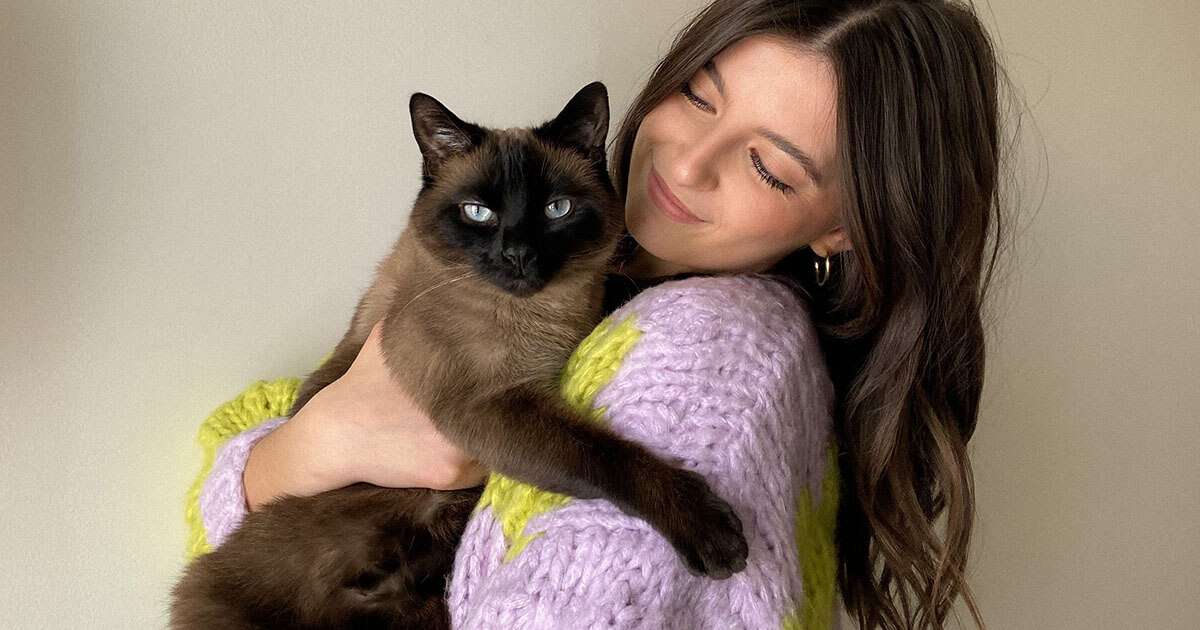Just like humans, cats can have anxiety. And just like humans, it can impact them physically and mentally. An anxious cat may react with fear to new items or changes in their home, even to situations you don’t think would frighten them. It can be difficult to see your furry family member struggling this way, but there are many ways you can help. With a little detective work, patience, and time, you can identify the triggers for your cat’s anxiety and help them overcome it.
But first things first. Signs of anxiety can also be symptoms of a medical condition. If you feel your cat is suffering from anxiety, see your family veterinarian to rule out any underlying health issues. If a medical condition is uncovered, treatment may be all that’s needed to get your kitty feeling like themselves again.
Signs of Fear and Anxiety in Cats
Once you’ve ruled out medical issues, the next step in helping your cat with their anxiety is to correctly identify it. Signs of anxiety in cats are generally more subtle than you’d think. Picture the “Halloween cat” with puffed-up hair, arched back, and a threatening hiss— that’s not what you’re likely to see. Although they can present in a variety of ways, anxiety symptoms fall into a few key categories.
Changes in their daily habits:
-
House-soiling issues, going outside the litter box
-
Changes in appetite or weight
-
Sleeping more
-
Diarrhea and/or vomiting
More significant signs of fear and anxiety include:
-
Trembling or shaking
-
Rapid breathing
-
Avoiding eye contact
-
Tail flicking or tightly held against their body
-
Dilated pupils
-
Hiding and withdrawal
-
Crouching down and/or leaning away
-
Hair standing up
-
Flattening ears against their head
-
Excessive vocalization through meowing, yowling, hissing, and growling
-
Licking their nose frequently
-
Excessive grooming often leading to hair loss or skin sores
-
Pacing around the house (typically accompanied by meowing)
-
Overreaction to noises and/or movement
-
Aggression towards people and/or other pets in the household
-
Destructive behaviors like furniture scratching
-
Following people around the house
Most of these signs could also be due to a medical condition. If you feel your cat is suffering from anxiety, see your veterinarian to rule out any underlying health issues. If a medical condition is uncovered, treatment may be all that’s needed to get your kitty feeling like themselves again.
If your cat is only having the occasional sign of fear or anxiety, it doesn’t necessarily mean they’re clinically anxious. They may just be reacting normally to something like a sudden loud noise or change to their routine. If they’re regularly experiencing more than one of the signs above, anxiety is a concern. Now you can get down to the business of helping to alleviate it.
How to Help a Cat with Anxiety
It’s important to understand that cat anxiety is rarely solved with just a single action. To truly help your cat and see lasting results, you’ll want to approach the problem from a few different angles simultaneously. You can apply this approach to almost any behavior concern:
Do you have an anxious cat? Chances are you’ve at least encountered one in your lifetime. Anxiety is somewhat common in felines, yet often overlooked due to the wide range of symptoms that may arise. Learn more about what cat anxiety is, which symptoms can occur, and how to go about treating your anxious cat.
What is cat anxiety?
Just as there are different types of anxiety in people, cat anxiety can manifest in many ways. PetMD designates three categories: phobia, or “a persistent and excessive fear of a specific stimulus, such as a thunderstorm”; fear, or “the instinctive feeling of apprehension resulting from a situation, person, or object that appears to present an external threat (whether real or perceived)”; and anxiety, or “the anticipation of future dangers from unknown or imagined origins that result in normal body reactions associated with fear.”
The important difference here is that anxiety is an ongoing condition (whereas fear and phobias are typically temporary). According to PetMD, cat anxiety is most likely to develop at the onset of social maturity—12 to 36 months of age.
via GIPHY
What causes it?
Although the most common form of anxiety in cats is separation anxiety, there are many environmental, behavioral, and health factors that may contribute to the disorder. Some common causes include:
- A past traumatic experience, such as physical abuse, neglect, abandonment, being caged for a prolonged period, etc.
- Being deprived of social and environmental exposure for the first 14 weeks of life or longer
- A change in routine, often resulting in separation anxiety
- An unfamiliar environment
- A new situation, such as the introduction of a new household pet or baby
- An illness, painful physical condition, or disease such as hyperthyroidism
- Aging, which may lead to cat dementia or other nervous disorders
Cat anxiety symptoms
An anxious cat may present obvious symptoms of discomfort, but many pet parents are surprised to learn about the not-so-obvious signs. Below is a round-up of common, wide-ranging cat anxiety symptoms:
- Urinating or defecating outside of the litter box
- Changes in eating or drinking, such as lack of appetite or eating too fast
- Hiding
- Vomiting
- Diarrhea
- Inappropriate scratching or destructive behavior
- Increased aggression
- Increased submission
- Compulsive pacing
- Over-grooming, sometimes to the point of hair loss
- Excessive vocalization
How to calm an anxious cat
If you’re worried about your anxious cat, you should first make an appointment with your veterinarian to rule out possible illnesses and diseases that could be contributing to his symptoms. Following that, you’ll need to try to get to the bottom of what is causing your cat’s anxiety. From there, you can tailor your treatment plan to suit your cat’s specific needs.
Create a safe space
This works for all kinds of anxiety, including phobias. If your cat is stressed out by kids or other pets in the household, give him an opportunity to escape the commotion with a tall cat tree, window perch, or even a separate room with a cozy bed and enclosed areas. This safe space is also important for cats with noise phobias (fireworks, thunderstorms, vacuums, etc.). You might consider trying a ThunderShirt on your cat, a pressure garment said to have a calming effect similar to swaddling a baby.
via GIPHY
Provide playtime and enrichment
Start (or continue) a daily routine of exercise and play with your cat. Even 15 minutes a day with a laser pointer or wand toy will help your cat get the exercise he needs while reducing his stress. Similar to creating a safe space, you’ll want to make sure your cat has enough environmental enrichment while you’re away to stay distracted from ensuing anxieties. Keep him stimulated with catnip toys, food puzzles, cat grass, and window-watching spots.
Stick to a routine—and clean the litter box more often!
An upheaval in your routine can result in separation anxiety in your cat. Give your cat food and water at the same time every day, and clean the litter box daily. That’s right, a common source of cat anxiety is a dirty litter box! Cats are such fastidious creatures that they don’t want to step into a dirty litter box too often—leading to urinating and defecating outside of the litter box, or potentially life-threatening lower urinary diseases. Make sure you scoop daily and follow the n+1 rule: If you have 1 cat, you need n+1 litter boxes (in other words, 2). If you have 3 cats, you need 3+1 litter boxes (a total of 4). Or, skip the scooping altogether and get an automatic, self-cleaning Litter-Robot, which always provides a clean bed of litter—great for territorial cats!
Of course, we can’t always avoid changes in schedule, so we recommend trying to ease your cat into a new routine whenever possible.
Try calming pheromone diffusers
Feliway is a natural calming pheromone that mimics your cat’s “happy” pheromones. Plug in a Feliway diffuser in any room where your cat spends a lot of time, or spray it on any spot where your cat has urinated, scratched, or engaged in destructive behavior.
via GIPHY
Use natural calming supplements
With the rise of natural calming supplements for pets, you have your choice of many natural treatments for your anxious cat:
- CBD: This natural compound from cannabis plants may reduce cat anxiety and comes in many varietals now, including treats, oils, and capsules. However, never give your pets regular marijuana, which contains THC.
- Bach Flower Rescue Remedy: This natural stress reliever is made from spring water infused with wild flowers. It is said to help ease an anxious pet by restoring balance between the mind and body.
- Anti-anxiety diets and treats: Ask your vet about Royal Canin Veterinary Diet Calm formula and other calming cat chews.
- Herbs: Find out which herbs are safe for cats, including catnip and valerian. While these herbs might initially stimulate your cat, the resulting euphoria should leave him calm and relaxed.
Visit the vet for cat anxiety medication
If all else fails, talk to your vet about prescription cat anxiety medication. He or she may want to prescribe something more short-term like gabapentin, or a longer-time resolution such as buspirone or amitriptyline. But never give your cat human anti-anxiety medication without first checking with your vet.
Remember, treating cat anxiety will probably be a lesson in patience and trial and error. Learn to recognize what, if anything, is triggering your cat’s anxiety and try the tips listed above. Don’t be afraid to ask your vet for advice. An anxious cat deserves as much care and attention as an ill kitty.
Cover photo: © Takashi Hososhima / CC-BY-SA-2.0
Source:
Recommendations







